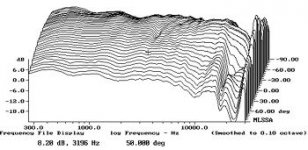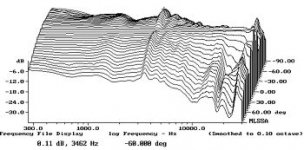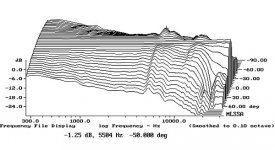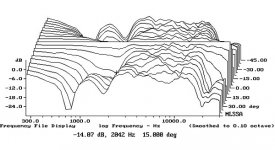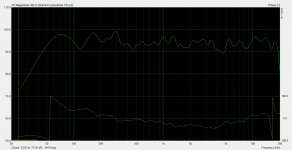Wow ! Am I wrong or is that not too shabby at all????
So....in thinking about this, the only thing you lose with a more shallow conical horn might be a bit of efficiency, but man is that ever made up for in the multiplicity of drivers! Hate to use the phrase no brainer, but damn! Starting to think there really are no gotchas here! So far then, the only thing anyone has really put forward is a lack of 'radiation depth' which to me and my kind is really a plus (for mixing not mastering) Starting to think this would make one hell of a near field monitor unit, far field soffit mounted too for the matter!
Hi
That curve is representative of any side mounted driver including the mid drivers you speak of but also the woofer response looks like that (but in a lower frequency band).
In the modeled response, the cancellation notch i mentioned that limits the upper end of the response is obvious as well as the "low pass" acoustic filter formed by the trapped air volume and port mass. Within the band pass range, the response is that one would see if the horn were driven normally at the end. That acoustic low pass filter reduces the harmonic distortion all drivers produce because that falls above the normal operating band.
By choosing the band passes appropriately, one can overlap each section so that you drive the single acoustic path continuously over a much broader bandwidth and with the proper crossover, as if there were only one driver.
Hope that helps;
Best,
Tom
I had asked our programmer to take the 3d polar balloon from the an SH-50’s CLF data and plot that as a map like some hifi speakers use (attached). Note this is a full bandwidth (30Hz to 16kHz) data plot with 3 dB per color division. If you compare that to hifi speakers you will notice the pattern control extends down much lower in frequency than normal. Much less energy is projected 90 degrees off axis or elsewhere outside the pattern.
Gainphile, the directivity needed for larger room is only possible with large size in fact we make much larger speakers than the SH-50 plot shown here (which has a 28 inch square mouth).
The flatness issue is addressed in post #6
Best,
Tom
Hi Tom
That is not a particularly high resolution polar map and it is normalized, which deforms everything anyways, so its kind of hard to tell, but that is not a particularly good polar map for a Hi-Fi speaker. At least not ones that I am used to hearing. Its directivity control does go very low, but as we both know that's all a matter of size. And in a small listening room it is not as critical to go low as it is in larger venues.
The unity/synergy approach is great when one needs mega-power, but I would not agree that it is the ideal approach when the power requirements are much lower as they are in a small listening room.
What would you find non-ideal? Size? Cost? Complexity? I can see any or all of those as less than optimum for many rooms. Something else?... but I would not agree that it is the ideal approach when the power requirements are much lower as they are in a small listening room.
I think we all have a pretty good idea of what two drivers in a box costs to build vs. a new complex unit like the Synergy.What would you find non-ideal? Size? Cost? Complexity? I can see any or all of those as less than optimum for many rooms. Something else?
When I started this thread the thought of it being in contention with totally conventional two way speakers was ridiculous. And still is. They are not comparable.
Anytime you can get the all of the critical mid extending all the way to extreme HF with good FR/polar coming from one point source it is totally appropriate for ANY venue. If that area is not ragged the superiority of this approach is nearly beyond
debate. Point source is the holy grail, clearly.
debate. Point source is the holy grail, clearly.
Hi Tom
That is not a particularly high resolution polar map and it is normalized, which deforms everything anyways, so its kind of hard to tell, but that is not a particularly good polar map for a Hi-Fi speaker. At least not ones that I am used to heas directivity control does go very low, but as we both know that's all a matter of size. And in a small listening room it is not as critical to go low as it is in larger venues.
The unity/synergy approach is great when one needs mega-power, but I would not agree that it is the ideal approach when the power requirements are much lower as they are in a small listening room.
Hi Tom
That is not a particularly high resolution polar map and it is normalized, which deforms everything anyways, so its kind of hard to tell, but that is not a particularly good polar map for a Hi-Fi speaker. At least not ones that I am used to hearing. Its directivity control does go very low, but as we both know that's all a matter of size. And in a small listening room it is not as critical to go low as it is in larger venues.
The unity/synergy approach is great when one needs mega-power, but I would not agree that it is the ideal approach when the power requirements are much lower as they are in a small listening room.
Hi Earl
It isn’t super “high resolution”, it was derived from the data taken by an independent company that does all of our 3D full spherical measurements, at 5 degree increments at 7.4 meters distance, it is already a lot of data points to take. I asked our programmer to take the CLF data file and plot the H and V planes in the Map style which is popular in hifi. What one can see is that the level going at say 90 degrees off axis is -20dB or lower down to a fairly low frequency and like you said, it is size dependant but also lacking the lobes and nulls of most conventional multiway speakers is a help there (the SH-50 is a 3 way with 7 drivers).
I do not know where the point of diminishing returns is so far as minimizing off axis energy in a living room however but I do know these project less than any of the speakers that Floyd Toole examined.
Like they say, the simplest thing that does the job is usually the best and if I were sitting in the very near field or outdoors the amount of directivity is irrelevant. Up close, I have heard an EQ’d accuton driver on a large flat baffle which worked remarkably well and like the Synergy horn, had very little spatial identity; one could not easily tell how far away it was when your eyes were closed and playing a soft voice.
Understand too it is possible to make them very “flat” (smooth) with more crossover parts , as much as I would like to make a hifi version and hifi (home audio) has been my hobby since childhood we don’t yet. Even when I get the ok, these won’t be for everyone, they will never be small loudspeakers though and even a modified SM-60 which is my best bet now (measures + - 1dB deviation) , isn’t small.
Best,
Tom
I think we all have a pretty good idea of what two drivers in a box costs to build vs. a new complex unit like the Synergy.
When I started this thread the thought of it being in contention with totally conventional two way speakers was ridiculous. And still is. They are not comparable.
In the context of a typical domestic application they are easily comparable - provided you have similar quality graphical plots.
Of course it's not going to tell you "everything".. but quite a lot.
..and with respect to plots and resolution, Earl's are actually some of the best available. Even on his though I'd like to see finer resolution (db) and better "mapping" of the differences (..like REW can provide). Still, Tom's are better than most manufacturers. Really the better source for *comparison* is JA's numerous lateral and vertical plots in Stereophile - simply because of the shear number and variety of loudspeakers ..and that the display (despite the res.) is fairly easy to read with respect to spotting problems.
Ex.'s (Horizontal and Verticals of the Revel Ultima Studio and YGA Sonja):
Attachments
Last edited:
What would you find non-ideal? Size? Cost? Complexity? I can see any or all of those as less than optimum for many rooms. Something else?
Combining multiple drivers into a single horn is never ideal. Look at any of the dual diaphragm compression drivers in the marketplace. None have a decent response at the crossover point. I would suspect something of the sort with the synergy technique.
When one needs multiple drivers for power considerations then there are many good options and the synergy is one of the better ones. But when one can get by with a minimum of drivers (above the modal region - almost everything is opposite from above and below the modal region) then that is always going to be the better approach.
I would suspect that a dual driver entering into a tube and then a horn does something a lot different than the Synergy is doing, it would have to. I also suspect that the conventional 2 driver speaker box with a compression driver was absolutely perfected by your design. And also in the designs of 2000, 1990, 1980, 1970, 1960, 1950, 1940...........
Combining multiple drivers into a single horn is never ideal. Look at any of the dual diaphragm compression drivers in the marketplace. None have a decent response at the crossover point. I would suspect something of the sort with the synergy technique.
When one needs multiple drivers for power considerations then there are many good options and the synergy is one of the better ones. But when one can get by with a minimum of drivers (above the modal region - almost everything is opposite from above and below the modal region) then that is always going to be the better approach.
Hi Scott
..So far as what can be measured, one can’t measure stereo image, that is subjective but what you can measure is the MTF for a loudspeaker.
An MTF is a measure of resolution; see the link below as it applies to optics;
Modulation Transfer Function - what is it and why does it matter? - photo.net
For a loudspeaker, one can measure the depth of modulation also, that depth is the difference between on and off producing a tone, turing on and off at an increasing rate.
A series of these MTF’s allow one to calculate a prediction of language independent speech intelligibility called STIpa.
STIPA Pro | Studio Six Digital
If you take your own MTF’s with say ARTA, one sees that just as in intelligibility, as you add reflected sound, the depth of modulation / articulation is reduced. MANY things limit the MTF but among them is the direct to reflected sound level difference captured by the MTF.
Now it is certainly possible to have a very poor articulation but also have very enjoyable sound, if you hear a choir in a large church that is an extreme example.
What I am talking about is what governs how much of the signal information reaches your ears as intended.
I hope this fills in some blanks
Best,
Tom
Hi Tom,
-got a chance to more thoroughly digest the information from your post #60 in this thread, and I’m going to (try to) respond in “blocks” (as I can).
I’m going to do my best to respond to the quoted above portion of the post first.
1st – adding reflections (or noise) to a test signal (as an objective measure) is not at all the same as listening to a test signal in the presence of reflections. Unless I’m misinterpreting here, that seems to be what you are suggesting: “..as you add reflected sound, the depth of modulation / articulation is reduced.”
2nd – The Speech Transmission Index seems to be rather poorly correlated with small room acoustics, and specifically – poorly with regard to reflections ONLY in a small room acoustic.
3rd – Intelligibility with respect to reflections in a small room acoustic actually INCREASES. See Toole’s synopsis in 10.3 of Sound Reproduction:
Sound Reproduction > CHAPTER 10: Reflections and Speech Intelligibility > 10.3 MULTIPLE REFLECTIONS, NOISE, AND SPEECH INTELLIGIBILITY - Pg. 162: Safari Books Online
Note that extraneous noise in the room (..also usually lowered through room treatment intended to suppress reflections in a small room), perceptually reduces the correlation of reflections and direct sound – thereby reducing intelligibility.
At least with respect to Intelligibility as a subset of a stereo image, near time reflections are BENEFICAL to that stereo image.
For more information Google: “early reflection benefit”.
Last edited:
Combining multiple drivers into a single horn is never ideal. Look at any of the dual diaphragm compression drivers in the marketplace. None have a decent response at the crossover point. I would suspect something of the sort with the synergy technique.
When one needs multiple drivers for power considerations then there are many good options and the synergy is one of the better ones. But when one can get by with a minimum of drivers (above the modal region - almost everything is opposite from above and below the modal region) then that is always going to be the better approach.
Hi Earl
You are right about the coaxial compression drivers, I use them in a couple loudspeakers at work and the hf/mhf sections do not combine acoustically into one new source. They DO NOT meet the requirement for the Synergy horn either where the dimensions need to be no more than a quarter wavelength where they sources combine. For example, the 1.4 inch exit BMS 4592 version I use requires a crossover around 7KHz while the dimensions for a Synergy horn would require one no high than about 2400Hz. Also, the “time” between the two is not correct. That being said, it is the most powerful source one can get in a 1.4 inch or even 2 inch exit.
Consider what happens if you take two subwoofers and put them side by side, do a polar plot outdoors and you one round pattern, no interference pattern because they add coherently into one new source. They behave that way until the radiators approach a ¼ wavelength separation.
The same is true in the Synergy horn, ALL of the interacting sources must be less than ¼ wavelength apart at the highest frequency of interest if they are to add coherently into one new source. When you drive a horn with multiple sources but do so where the horn dimension is less than ¼ wave length, what propagates is also as if it were one source.
The data sheet for the speakers at work are measured in a warehouse not an ideal location and I don’t have any have any anechoic measurements handy, but what I do have is a 1 meter measurement in my cluttered living room of one of my SH-50’s.
There is a significant floor bounce notch around 130hz, not present when measured up in the air or with the mic on the ground. This is a 3 way speaker the upper / mid and lower ranges overlap / crossover around 300Hz and 1100Hz. Note the crossover is not only not obvious, but also that unlike all conventional crossovers, there is no appreciable crossover phase shift (normally N order times 90 degrees). What this phase looks like is a single driver, not a three way speaker with 7 drivers, they really do combine into one new source..
I would agree, these are overkill in a living room and in commercial sound, you can’t have too much difference between the front and side / rear radiation. So maybe that directivity is not needed in a living room, but I don’t know, I think that would require a comparison to make a subjective judgment.
If you go by Modulation Transfer Function comparisons in a living room, it also looks like (all other things being equal) the more direct energy you have relative to reflected sound, the better
Best,
Tom
Attachments
Hi Scott
Your reference is well out of date, while it has some valuable information, because of life safety warning systems and the legal implications; the “art” has proceeded considerably.
For large scale sound, there are legal requirements for intelligibility that are in force now in Europe and soon here, so a great deal of effort has been expended in an effort to be able to predict based on measurements and design systems beforehand which meet the legal requirements.
The STIpa measurement is now the standard for that legal predictor, it is language independent and correlates very well with the understanding of random words using real people. AS this is part of our business at work, I have to go to these seminars to keep up. For example, somewhere in the audience in the second link is myself, Ivan Mike and Dr Jones from our company.
SynAudCon ECS Speech Intelligibility Workshop Overview - YouTube
SynAudCon Clarifies Intelligibility at ECS Speech Intelligibility Workshop Synergetic Audio Concepts
I think you may have misunderstood what I was getting at too, an MTF is a measure of resolution, while they (a series of 7 bands and voice weighted amplitude) are used to make a STIpa measurement, I am not suggesting STIpa is a predictor of stereo image enjoyment but rather, the MTF’s at various frequencies DO show how much of the original signal arrives at the LP, how much resolution the speaker has.
That is where the information is that delivered.
AS I explained resolution is not required to be enjoyable, like I said a choir singing in a large church has essentially no intelligibility but can be very pleasing.
On the other hand, you cannot make the recorded signal any better or a speaker more faithful to the input signal, by adding reflected sounds related to your room to it, even if it’s pleasant.
Best,
Tom
Your reference is well out of date, while it has some valuable information, because of life safety warning systems and the legal implications; the “art” has proceeded considerably.
For large scale sound, there are legal requirements for intelligibility that are in force now in Europe and soon here, so a great deal of effort has been expended in an effort to be able to predict based on measurements and design systems beforehand which meet the legal requirements.
The STIpa measurement is now the standard for that legal predictor, it is language independent and correlates very well with the understanding of random words using real people. AS this is part of our business at work, I have to go to these seminars to keep up. For example, somewhere in the audience in the second link is myself, Ivan Mike and Dr Jones from our company.
SynAudCon ECS Speech Intelligibility Workshop Overview - YouTube
SynAudCon Clarifies Intelligibility at ECS Speech Intelligibility Workshop Synergetic Audio Concepts
I think you may have misunderstood what I was getting at too, an MTF is a measure of resolution, while they (a series of 7 bands and voice weighted amplitude) are used to make a STIpa measurement, I am not suggesting STIpa is a predictor of stereo image enjoyment but rather, the MTF’s at various frequencies DO show how much of the original signal arrives at the LP, how much resolution the speaker has.
That is where the information is that delivered.
AS I explained resolution is not required to be enjoyable, like I said a choir singing in a large church has essentially no intelligibility but can be very pleasing.
On the other hand, you cannot make the recorded signal any better or a speaker more faithful to the input signal, by adding reflected sounds related to your room to it, even if it’s pleasant.
Best,
Tom
Hi Scott
Your reference is well out of date..
Best,
Tom
Hi Tom,
Which reference?
The Synergy series and Geddes' speakers of course have different vertical behavior, different strengths outside of directivity, etc., but it seems like many people here are curious how they differ in response where they are comparable in a straightforward way - horizontal polars. I don't think comparing these two available gets very far in that respect.

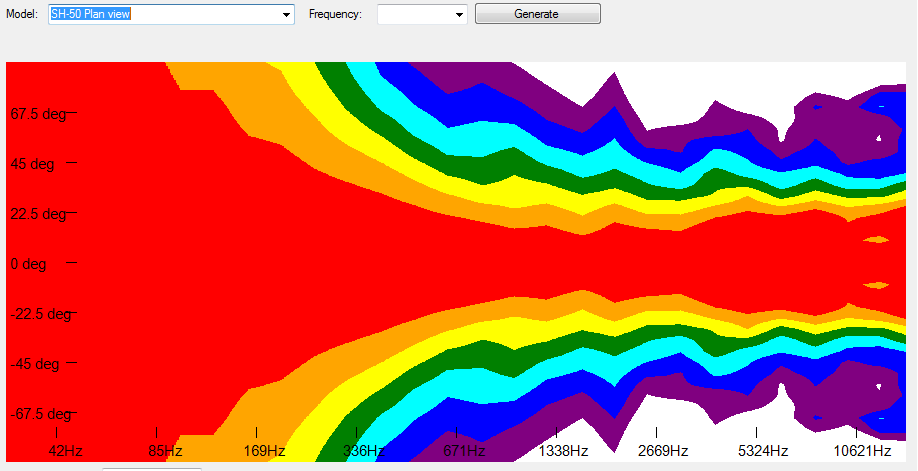


Hi Scott
..I think you may have misunderstood what I was getting at too, an MTF is a measure of resolution, while they (a series of 7 bands and voice weighted amplitude) are used to make a STIpa measurement, I am not suggesting STIpa is a predictor of stereo image enjoyment but rather, the MTF’s at various frequencies DO show how much of the original signal arrives at the LP, how much resolution the speaker has.
That is where the information is that delivered.
AS I explained resolution is not required to be enjoyable, like I said a choir singing in a large church has essentially no intelligibility but can be very pleasing.
On the other hand, you cannot make the recorded signal any better or a speaker more faithful to the input signal, by adding reflected sounds related to your room to it, even if it’s pleasant.
Best,
Tom
Hi Tom,
All of the direct sound's resolution end's up at the listener's position. Likewise, a short time later all of the reflections end up at the listener's position.
Trying to "stamp" noise onto a signal, measure it at a given position, conclude that sure enough the signal is no longer as clean - won't work.
In this context we are looking at how average listener's processes this information and then make a determination.
The listener is effectively using this noise (reflections) as a side-band comparison to the direct sound that preceded it.
This is not about preference as if it were an additive coloration to the signal.
Note: If you have more up-to-date material in a small room context on this topic then pleases provide a few links if possible.
BTW, this line of discussion though interesting - is getting pretty far from the thread's purpose.
Last edited:
Scott
The STIpa measurement is now a legally binding measurement that has proven to be both language independent and very well correlated to the results one gets using thousands of random words and many many listeners to derive the figure, the latter was the only ‘proof” of intelligibility before this.
It is language independent because it is a measure of the ability to transmit information to the ears which is not a language depend our ears all work the same way.
Understand, I am not talking about anything subjective enjoyment, I am talking about resolution. Speakers are like every part of the reproduction chain, you cannot get closer to signal faithful by adding “stuff” not present in the original recording.
Those delayed reflections might be unavoidable but this isn’t the same as saying they belong there as part of the original or help transfer the original information.
The clearest demonstration of this is to set up your stereo outdoors, in the same distance and angle as it was in your home BUT outdoors with no walls anywhere nearby. You will hear two things, less bass than before AND a much better / real stereo image in the recordings that contain it. Other aspects of speaker performance govern it’s ability to make an image but taking away the room effects makes an improvement the tangibility of image on every speaker I have tried it with. Try it, besides It also gives you an excuse to have a BBQ and listen to your favorite tunes.
If you have ARTA or another way to measure time of what your system does, take an ETC or CBD at the lp in the room and outside at the lp. Which one is cleaner, closer to ideal?
Tom
The STIpa measurement is now a legally binding measurement that has proven to be both language independent and very well correlated to the results one gets using thousands of random words and many many listeners to derive the figure, the latter was the only ‘proof” of intelligibility before this.
It is language independent because it is a measure of the ability to transmit information to the ears which is not a language depend our ears all work the same way.
Understand, I am not talking about anything subjective enjoyment, I am talking about resolution. Speakers are like every part of the reproduction chain, you cannot get closer to signal faithful by adding “stuff” not present in the original recording.
Those delayed reflections might be unavoidable but this isn’t the same as saying they belong there as part of the original or help transfer the original information.
The clearest demonstration of this is to set up your stereo outdoors, in the same distance and angle as it was in your home BUT outdoors with no walls anywhere nearby. You will hear two things, less bass than before AND a much better / real stereo image in the recordings that contain it. Other aspects of speaker performance govern it’s ability to make an image but taking away the room effects makes an improvement the tangibility of image on every speaker I have tried it with. Try it, besides It also gives you an excuse to have a BBQ and listen to your favorite tunes.
If you have ARTA or another way to measure time of what your system does, take an ETC or CBD at the lp in the room and outside at the lp. Which one is cleaner, closer to ideal?
Tom
Scott
The STIpa measurement is now a legally binding measurement that has proven to be both language independent and very well correlated to the results one gets using thousands of random words and many many listeners to derive the figure, the latter was the only ‘proof” of intelligibility before this.
It is language independent because it is a measure of the ability to transmit information to the ears which is not a language depend our ears all work the same way.
Understand, I am not talking about anything subjective enjoyment, I am talking about resolution.
Speakers are like every part of the reproduction chain, you cannot get closer to signal faithful by adding “stuff” not present in the original recording.
Those delayed reflections might be unavoidable but this isn’t the same as saying they belong there as part of the original or help transfer the original information.
The clearest demonstration of this is to set up your stereo outdoors, in the same distance and angle as it was in your home BUT outdoors with no walls anywhere nearby.
You will hear two things, less bass than before AND a much better / real stereo image in the recordings that contain it.
Other aspects of speaker performance govern it’s ability to make an image but taking away the room effects makes an improvement the tangibility of image on every speaker I have tried it with.
Try it, besides It also gives you an excuse to have a BBQ and listen to your favorite tunes.
If you have ARTA or another way to measure time of what your system does, take an ETC or CBD at the lp in the room and outside at the lp. Which one is cleaner, closer to ideal?
Tom
Hi Tom,
I've not disputed what an STIpa measurement is, rather it's specific applicability in this context.
I don't think it's terribly relevant, and talking about how wide-spread its use is and that it is language independent or even how standardized it is (legally or otherwise), doesn't help explain its relevance in this specific context.
I understand your position.. and I've said as much as I will.
However, I have done the "outside test" - *many* times, and I've even advocated it's use to others. (..markus, are you there?
And every time it has NOT produced a "better" higher freq. image. (..and yes, I've specifically done testing in this respect with limited bandwidth for exactly this reason. It was always on a golf-course green btw - late at night with only very rare non-wildlife noise. ..though I've got to say that when you lower the overall ambient noise and some wildlife starts acting up - it sounds rather loud.
Moreover, MOST of the on-point research in this area (as I've mentioned to you before in another thread) STARTs with a room that is anechoic, or near anechoic at higher freq.s.. While that's different than being outside, I don't think it's usefully different in this context.
Again, if you have more up-to-date and relevant research I'm "all ears" as they say.
While we are going to this extreme, why not advocate a heavily treated room to get all the resolution (as you put it) that you can? At that point you don't need a high directivity loudspeaker at all..
Note: In a small room context the reflections are going to be present regardless of the directivity unless they are suppressed. Because of the relatively "continuous" nature of music reproduction, IF we subscribe to the corrupted signal paradigm, then there isn't going to be a huge difference between one speaker and the next in this respect - the reflections are still there and they are still pretty high in amplitude. The nature of the corruption may be marginally different, but the corruption is still corruption (..or loss of resolution).
Last edited:
My only problem with the synergy approach is that like all other horn based approaches, you can't control directivity at low frequencies in domestically sized packages. You either feel controlled directivity at lower frequencies adds to the reality of sound reproduction, or you don't. If you do, you are led down one road very distant from the synergy. If you don't, you are led down another road along which the synergy is a superb implementation. I have yet to read about or myself determine how make the roads intersect.
Some recording rules that are germane here as well. Drums for example, are best recorded in a room large enough so that you don't get comb filtering etc. from wall reflections and has decent decay characteristics. In practice you simple select a room or create a room with the right size and reverb decay properties. If you can't do that, and you are stuck with average random rooms, you do whatever the hell is needed to to get the room out of those mics. If this means over-damping a room, then it must be done. You are far better off not lighting up a bad room and if that means using directional mics or over damping the room so be it. Speakers on the whole do not need to light up a room, it might be a bad room. Speakers need to light up the people in front of the speakers. This is not anything that requires a second or third look. Only in certain rooms can you afford speakers that are not more directional. Directional is a PLUS. Given one choice for the greatest cross section of situations, you do not want to light up the room. The room will light up itself plenty.
Last edited:
- Status
- This old topic is closed. If you want to reopen this topic, contact a moderator using the "Report Post" button.
- Home
- Loudspeakers
- Multi-Way
- Synergy Horns. No drawbacks, no issues?
